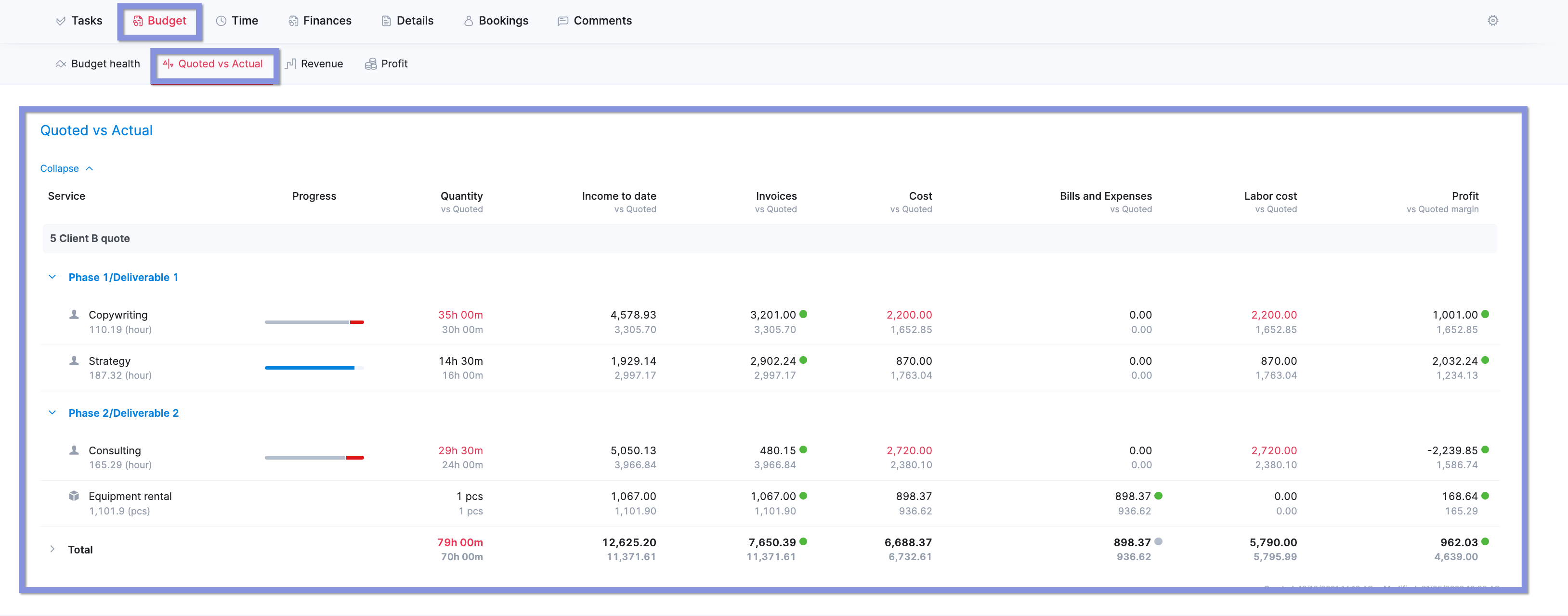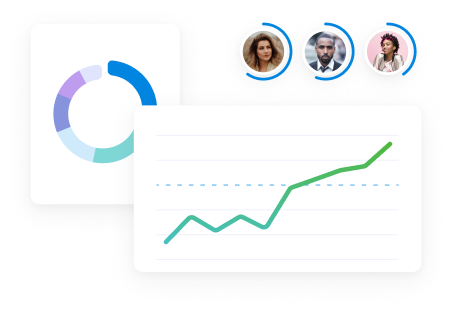Getting your project estimates right means better margins, happier clients, and fewer stressful conversations about budget overruns and delays.
But without a clear approach, trying to make them more precise is tough.
Try these proven project estimation techniques as a starting point for more accurate project plans.
Here’s a quick summary of all the methods discussed below:
| Technique | Pros | Cons |
|---|---|---|
| Analogy-Based Estimation | Lets you create reliable estimates based on similar completed projects | Only works when you have accurate historical data across your portfolio |
| Top-Down Estimation | Delivers quick, high-level estimates perfect for initial client conversations | Less accurate since you’re estimating at a high level without examining the detailed work required |
| Bottom-Up Estimation | Provides highly accurate estimates by breaking down costs and hours for every project task | Demands extensive planning time and can overcomplicate early project discussions |
| Three-Point Estimation | Accounts for both optimistic and pessimistic scenarios to create more realistic timelines | Requires significant time to calculate multiple scenarios for each project phase |
| Parametric Estimation | Uses standardized metrics to quickly estimate costs and time for common project types (like website builds) | Not applicable when projects deviate from standard hours or rates or contain custom elements |
| Expert Judgment | Taps into seasoned professionals’ knowledge for quick estimates on new projects | Feedback can vary widely between experts because it’s based on their unique experiences |
Now, let’s go through each technique in more detail.
1. Analogy-based estimation
Analogy-based estimation involves analyzing completed projects that are similar to your current one. So you can anchor your estimates in proven data rather than guesswork, reducing uncertainty and increasing accuracy.
This project cost estimation approach works especially well for bigger companies with lots of historical project data.
You can search your archives and find projects that match your current situation. Like similar deliverables, timelines, staff needs, or challenges. And use that information as a foundation for your estimates.
It’s also useful for agencies and consultancies handling recurring project types. Think website updates, marketing campaigns, software maintenance—anything that tends to include similar tasks.
Say you run a marketing agency. Your team just got a social media marketing campaign request.
Last month, a similar project took six weeks and cost $20,000. But this new one also needs TikTok videos and Instagram Reels—content that wasn’t in your previous work.
Based on those extra deliverables, you estimate eight weeks and $25,000.
Top Tip
Review completed projects in Scoro and look at the “Quoted vs Actual” table to identify cost variances, assess project profitability, and refine future estimates.
By comparing initial estimates with actual tracked costs and hours, you can spot patterns in overruns, optimize resource allocation, and improve the accuracy of your project quotes.

Pros & cons
| Pros | Cons |
|---|---|
| Quick and simple: If you consistently track project data, all you need to do is review the numbers you’ve collected. | Depends on similarity: Past projects need careful comparisons. Even if the end deliverables are the same, different clients may have very different expectations, approval processes, or scope requirements that impact timelines and costs. |
| Based on real data: You’re working with actual hours and costs from projects your team already completed. So you can objectively determine what resources you need to deliver a successful project. | Not suitable for brand-new project types: When a client asks for something you’ve never done before, past project data won’t really help. For example, you can’t compare building a mobile app to running email campaigns. |
| Reduces guesswork: No more wild guesses about timelines and budgets—you’ve got clear roadmaps to follow. This decreases the risk of planning unrealistic deadlines or budgets. | Needs solid tracking to be effective: Your past project data needs to be accurate and detailed. If your final costs aren’t correct or your team didn’t track time consistently, those errors will mess up your new estimates. |
2. Top-down estimation
With top-down estimation, you use a big-picture budget or timeline as your quote foundation. Basically, you start with this end goal and work backward to create distinct phases from it.
Take a $150,000 web development project. You might split it like this:
- Strategy: $30,000 (three weeks)
- Design: $45,000 (six weeks)
- Development: $52,500 (eight weeks)
- Testing: $15,000 (two weeks)
- Project management: $7,500
This creates financial boundaries up front, giving you (and clients) an idea of how much you need to spend and when.
Top-down estimation is great when:
- Clients need rough cost ranges or timeframes in the early proposal stage before they commit
- You need quick internal projections for resource planning
- You’re working on large projects with distinct phases
And for bigger companies handling multiple proposals, it’s a great time-saver. You can quickly give clients ballpark figures and create tentative capacity plans without spending days on detailed estimates that might never get approved.
Pros & cons
| Pros | Cons |
|---|---|
| Quick and high-level: Because you’re only outlining major phases and deliverables, you get initial proposals out the door, fast. | Less accurate: High-level estimates don’t reflect the nuances of each project (like timelines, tasks, and labor rates). So, without further adjusting, you’re at risk for overruns. |
| Easier for initial budgeting: For fixed budgets, you can quickly figure out how much money and time to set aside for each major phase without getting lost in the details. | Lacks granularity: Without breaking down individual tasks, you can’t account for potential roadblocks and complexities within project phases (like dependencies). Which makes it easy to underestimate resource needs. |
| Helps with stakeholder buy-in: This approach only gives decision-makers high-level details they need to move forward with a proposal. So they don’t get lost in extra info. | Challenging to adjust: Since there’s no detailed work breakdown, it’s harder to adjust your project plan if scope changes come up. You’ll have to spend a lot of time manually reordering workflows and assignments. |
3. Bottom-up estimation
Bottom-up estimation is a project management estimation method that starts by detailing every task needed to complete a project. You estimate each task’s time and costs, then add them up to calculate the total scope.
Because you break down each project step, bottom-up estimating is very accurate. It’s especially helpful for fixed-fee projects where it’s easy to accidentally overlook small tasks—and hurt your profits in the process.
Bigger companies with complex portfolios also benefit from this detailed approach, getting clear insight into:
- Who needs to do what and when
- Potential roadblocks
- Specific costs, right down to individual tasks
Let’s look at a social media campaign project. Using the bottom-up approach, you’d map it out like this:
- Research and strategy: 15 hours
- Social media strategist ($175/hour): 10 hours = $1,750
- Market researcher ($150/hour): 5 hours = $750
- Content creation: 25 hours
- Copywriter ($140/hour): 15 hours = $2,100
- Graphic designer ($160/hour): 10 hours = $1,600
- Revisions and approval: 10 hours
- Copywriter ($140/hour): 5 hours = $700
- Graphic designer ($160/hour): 5 hours = $800
- Campaign execution: 20 hours
- Social media manager ($130/hour): 15 hours = $1,950
- Community manager ($120/hour): 5 hours = $600
- Analytics and reporting: 8 hours
- Data analyst ($165/hour): 5 hours = $825
- Social media strategist ($175/hour): 3 hours = $525
Add these components together, and the total campaign cost would be $11,600 for 78 hours of work. You can use this same process to estimate costs for campaigns of different sizes by adjusting the hours based on the number of posts, platforms, or campaign duration.
Pros & cons
| Pros | Cons |
|---|---|
| Highly accurate: Breaking down every component means fewer mid-project surprises. You can spot potential issues early and account for dependencies between tasks. | Time-consuming: Breaking down and estimating resource needs for each task takes work. Small projects can become unnecessarily complex, and large ones can feel overwhelming. |
| Supports detailed planning: You know exactly which roles need to do what and when. This makes it easier to schedule team members and optimize their billable hours without burning them out. | Lack of flexibility: With detailed task lists and dependencies, the smallest scope change can throw off your whole workflow. Which means you’ll need to take time to reconfigure it. |
| Transparent for stakeholders: Everyone can see how much money and time is allocated to specific deliverables. So you can show clients exactly what they’re paying for and reduce the need for extensive back-and-forth conversations. | Risk of over-estimating: Small time buffers in tasks can compound into inflated, unrealistic estimates that make your proposal less competitive and could cost you the project. |
4. Three-point estimation
Using the three-point estimation approach involves considering three project scenarios: optimistic (best case), most likely (expected case), and pessimistic (worst case).
From there, you calculate a weighted time or cost average using the Program Evaluation and Review Technique (PERT) formula:
[Optimistic + Pessimistic + (4 x Most Likely)] / 6.
Let’s say your team’s blended rate is $150 per hour for web development work. You’ll apply this rate across three scenarios:
- Optimistic: 50 hours ($7,500) with rapid client approvals and minimal revisions
- Most likely: 75 hours ($11,250) with standard feedback cycles and typical revision rounds
- Pessimistic: 120 hours ($18,000) accounting for multiple revision cycles and potential technical hurdles
Then, you plug those numbers into PERT: ($7,500 + $18,000 + 4×$11,250) ÷ 6 = $11,700
By factoring in different levels of risk and outcomes (and giving the most validity to the most likely scenario), you can create realistic estimates and buffers that keep projects running smoothly. And meet client expectations.
Three-point estimation is a good fit for complex projects where things can quickly get off track—like launching new software or a big marketing campaign.
Pros & cons
| Pros | Cons |
|---|---|
| Improves accuracy: By giving the most weight to your most-likely scenario while still accounting for best and worst cases, you create estimates that realistically reflect the standard delivery process. | Time-intensive: Creating three different estimates takes effort. Some projects just need quick ballpark figures to get moving. |
| Mitigates risks: Because your estimates add in buffers for real-world complications, you can avoid painful conversations later on about blown deadlines and budget overruns. | Relies on personal judgment: Your estimates are only as good as your understanding of what could happen. Your numbers will be off if you miss potential problems or overestimate risks. |
| Encourages deeper thinking: When considering multiple scenarios, spotting potential issues is easier. No more getting blindsided by preventable problems. | Can get too cautious: It’s easy to go overboard with worst-case-scenario numbers. You might end up padding estimates so much that your projects look unnecessarily expensive or long. |
5. Parametric estimation
Parametric estimation is when you determine hours or costs for deliverables with simple multiplication:
(Known hours and/or labor rates per unit) × (Number of units) = Estimate
Say your senior copywriter’s hourly rate is $100 and they need to write 15 webpages, with each one roughly taking an hour to complete.
You would need to allocate 15 hours (1 hour x 15 pages) on their schedule. And the total would be $1,500 ($100/hour x 15 hours).
Parametric estimation works great for bigger companies with:
- Historical project data
- Consistent time tracking
- Standardized deliverables and rates
Like an accounting firm during tax season. They know each corporate tax return takes about eight hours, so scheduling staff workloads and client deadlines during tax season becomes way easier.
Pros & cons
| Pros | Cons |
|---|---|
| Data-driven accuracy: Your estimates come from past project numbers, not gut feelings. So you can confidently predict costs and timelines. | Needs updated data: Your estimates are only as good as your historical records. Poor or incomplete tracking means inaccurate predictions, even with a clear formula. |
| Efficiency: Once you know your baseline hours and costs, estimating becomes straightforward. You can quickly size up projects of any scale using the same formula. | Limited flexibility for complex tasks: The formula isn’t useful for new or complex work that doesn’t follow standard rates and timeframes—like building custom features. |
| Easy to explain: Parametric estimates are easy to follow. And having transparent math behind your estimates helps build trust and credibility with prospects. | Ignores real-world challenges: Simply multiplying units by rates assumes everything will go perfectly, without accounting for common issues like feedback delays, revisions, or technical problems that affect your timeline and costs. |
6. Expert judgment
Expert judgment means working with seasoned professionals—whether from your internal team or external specialists—to estimate project timelines, costs, and resource requirements.
These pros have seen countless projects succeed (and crash). So they can spot potential budget-busters and timeline issues in advance. Like phases or tasks that might run over in costs and hours.
It works best for new or specialized projects where you don’t have historical data to guide your planning.
Say your company wants to launch a new B2B software platform for inventory management, but you’ve never tackled anything like it.
You consult a senior product manager on your team who’s successfully launched similar products at previous companies.
Based on her experience, she estimates:
- Time: Six months (based on product development and testing phases and the marketing rollout)
- Cost: $200,000 (covering development work, advertising campaigns, and launch events)
Her estimate comes from real-world experience, giving your projections a strong foundation—even without specific data points to reference.
But don’t just take one person’s word. Consult multiple colleagues, LinkedIn connections, and other industry experts to gain a balanced perspective.
Pros & cons
| Pros | Cons |
|---|---|
| Quick estimates: Experts can look at a project and give you their feedback right away. No need to spend days reviewing data when someone can immediately tell you what you’re dealing with. | Subjectivity: Different experts will give you different estimates based on their own experiences. One expert might recommend a smaller budget based on their fast-paced start-up experience, while another might recommend a higher one after dealing with similar projects that ran over. |
| Quick estimates: Experts can look at a project and give you their feedback right away. No need to spend days reviewing data when someone can immediately tell you what you’re dealing with. | Dependent on the expert’s knowledge: If they haven’t kept up with industry changes, your source’s estimates might be outdated. For example, they might be great at building marketing websites but less familiar with incorporating AI. |
| Leverages experience: People who’ve done the hands-on work know what to do (and what not to do) for a successful project. That kind of real-world wisdom helps you anticipate common risks and challenges that data alone might not reveal. | Lack of data: If stakeholders want to know how you got your estimate numbers, you can’t point to specific data points or calculations. You’re relying on professional judgment and experience, which can be a tougher sell in some organizations. |
Eliminate project estimation headaches with Scoro
Whichever estimation approach you use, the more accurate your project data is, the easier it is to build realistic proposals.
Just take it from creative agency WC+A. The company solved their issues with under- and over-quoting after switching to Scoro, leveraging insights on actual costs to maintain healthier margins while still staying competitive.
Start your free Scoro trial today to take control of your quoting process and boost your profitability.






